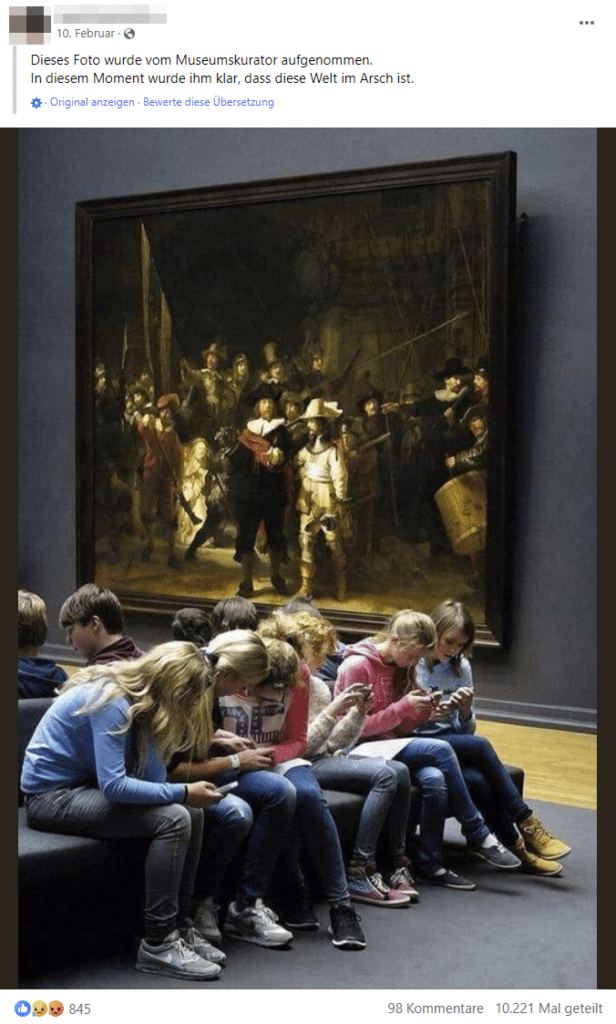The claim
A photo of teenagers looking at their smartphones instead of the painting “The Night Watch” at the Rijksmuseum Amsterdam is prompting users to make comments like “death of civilization.”
Our conclusion
This assumption is wrong. The Rijksmuseum specifically uses smartphones as interactive museum guides to offer visitors access to in-depth information and educational content through apps.
The common claim
The image of young people sitting in front of Rembrandt's "Night Watch" in Amsterdam's Rijksmuseum and staring at their smartphones has sparked intense criticism and disappointment on social media. Since 2014, this photo has been used to allow interpretations that the young generation is no longer interested in culture and art and is instead distracted by digital entertainment.

This assumption reflects widespread concern that smartphones and other technologies are leading to a shallowing of cultural awareness.
The fact check on the recording from the Rijksmuseum
However, a closer look at the circumstances of the photo and the context in which it was taken paints a different picture. In fact, the Rijksmuseum in Amsterdam offers an app ( Google Play / AppStore ) that provides visitors with detailed information about the works of art, including “The Night Watch.” The app contains background information, documentation, interactive learning games and quizzes.
The young people in the photo used their smartphones to delve deeper into the work of art with the help of this app. However, this fact was not taken into account in the original viral posts and the heated discussions that followed.
What we found out
The original interpretation of the photo, which reflects a negative attitude towards the use of technology in cultural contexts, does not stand up to critical scrutiny. Instead, the example shows how digital tools can enrich art education and deepen the engagement of visitors, especially the younger generation. The hasty conviction was based on a hasty conclusion without knowledge of the full facts.
Questions and answers on the topic
Question 1: Do smartphones undermine the appreciation of art and culture?
Answer 1: No, on the contrary, smartphones, when used correctly, can expand and deepen cultural experience.
Question 2: Why did the picture provoke such a strong reaction?
Answer 2: It is based on the premature assumption that young people are uninterested in art and are instead distracted by digital means.
Question 3: What does this example show about using social media?
Answer 3: It highlights the need to question hasty judgments and learn the context before drawing conclusions.
Question 4: Can digital tools improve the way we experience art?
Answer 4: Yes, they offer new opportunities for interaction and learning that can promote cultural understanding and appreciation.
Question 5: How should we respond when we encounter similar situations?
Answer 5: With an open mind and an effort to understand the full context before making a judgment.
Conclusion
This example clearly shows how important it is to question your own prejudices and quick judgments in the digital age. We should strive to look beyond first impressions and recognize and promote the positive aspects of using technology, particularly in education. Let us be open to the possibilities that digital tools offer to enrich our understanding and appreciation of art and culture.
Source: medium.com
Stay critical and informed – subscribe to our newsletter and register for our monthly online lectures and workshops .
You might also be interested in:
The audio clip of Navalny's mother: fact or fake?
Fact Check: The Truth Behind Yazan Kafarnah's Death
Karl Marx: The List He Never Wrote
Notes:
1) This content reflects the current state of affairs at the time of publication. The reproduction of individual images, screenshots, embeds or video sequences serves to discuss the topic. 2) Individual contributions were created through the use of machine assistance and were carefully checked by the Mimikama editorial team before publication. ( Reason )

